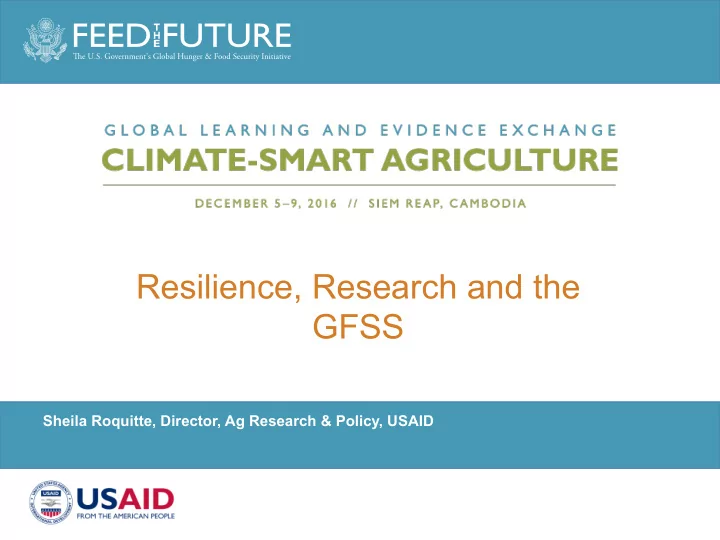

Resilience, Research and the GFSS Sheila Roquitte, Director, Ag Research & Policy, USAID Photo Credit Goes Here
OVERVIEW • Asia: a region of dynamic change 1 • Resilience definition & key concepts 2 • Research, Resilience and the GFSS 3
SECTION 1: ASIA: A REGION OF DYNAMIC CHANGE
WHAT DO WE KNOW ABOUT THE DECADES TO COME? Megatrends: • Economic / Globalization • Demographic • Urbanization • Interconnectedness / IT • Climate Change • Political
ECONOMIC • Asia to surpass Europe in market share • Fastest growing region • Consumption & investment increasing
DEMOGRAPHICS • By 2050, approx. 9.5 billion people • Poor countries grow, rich countries shrink • Aging population 1950 2015 2050 Asia By 2050, Asia’s population pyramid will be a population pillar.
URBANIZATION • Today, 2.4 billion reside in Asia’s urban areas • By 2025, an additional 1.1 billion will reside in Asia’s urban areas • 12 of world’s 23 megacities • Fastest growing, secondary cities Source: The State of Asian and Pacific Cities 2015 (UN-HABITAT)
IT / INTERCONNECTEDNESS • By 2035, microchips will have 1000x power • Big data applications • Leapfrog development • Economic ripple affects • Human, plant, & animal diseases
CLIMATE CHANGE • By 2050, resource and energy consumption could double • By 2050, temperatures up by 2-4 o C • Sea levels rise • Asia—most disaster-prone (75% hydro-met) • Increase the frequency and intensity of climate-related events
DOES POLITICAL CHANGE MATTER?
COMPLEX CHANGE Stresses, Trends & development context : • Social exclusion – gender • Poverty • Migration – positive & negative • Economic inequality - increasing • Ecological degradation • Governance • Food security • Health – burden of disease changing • Conflict
SECTION 2: RESILIENCE POLICY—DEFINITION AND KEY CONCEPTS
USAID DEFINES RESILIENCE AS: • the ability of people, households, communities, countries and systems (social, economic, ecological) to mitigate, adapt to and recover from shocks and stresses in a manner that reduces chronic vulnerability and facilitates inclusive growth Simplified version: • the ability to manage change and continue on the development path.
RESILIENCE AS A SET OF CAPACITIES Ability of people, Events and trends Outcomes of HHs, communities that impact well- interest—poverty , and systems … to being outcomes food security, mitigate, adapt to and future nutrition—also and recover from … resilience influence resilience capacities. capacities. * Includes covariate and idiosyncratic
KEY FEATURES OF USAID RESILIENCE EFFORTS (“WHAT’S DIFFERENT?”) 1) Developmental focus on people/places subject to recurrent crisis 2) Shocks and stresses explicitly recognized as perennial features (not anomalies) that transcend sectors. – Reduce and manage risk - absorptive capacity – Build adaptive capacity - adaptive capacity – Facilitate inclusive growth - transformative capacity 3) Joint, cross-sector analysis, planning and implementation through the sequencing, layering and integration of programs
MEASURING RESILIENCE CAPACITIES (EXAMPLE) Absorp*ve capacity Adap*ve capacity Transforma*ve capacity • Access to formal safety nets • Bonding social capital • Human capital • Availability telecoms (within community) • Bonding social capital networks • Shock preparedness • Bridging social capital • Access to markets and mitigation (outside community) • Access to infrastructure • Access to informal • Exposure to information • Access to basic services safety nets • Access to communal natural • Diversity of livelihoods resources • Availability of hazard (by risk profile) • Conflict mitigation and insurance • Access to financial management institutions • Household ability to resources • Access to livestock services cope with/recover • Bridging social capital • Asset ownership from shocks • Linking social capital (to • Aspirations and government info & services) confidence to adapt
SECTION 3: RESILIENCE IN ASIA
SUSTAINABLE POVERTY ESCAPES Even in Asia, at least 20% of those who escape poverty backslide into poverty. Bangladesh—studying why people backslide and relevant capacities for prevention.
RELEVANCE OF RESILIENCE TO CAMBODIA AND EFFORTS TO SUSTAINABLY END EXTREME POVERTY 51 % between poverty line and + $0.30 (and vulnerable to sliding back) 18% below the poverty line
RESILIENCE’S RAPID RISE AT USAID Jan 2014 OUR MISSION : WE PARTNER TO END EXTREME POVERTY AND PROMOTE RESILIENT, DEMOCRATIC SOCIETIES WHILE ADVANCING OUR SEURITY AND PROSPERITY. Center for Resilience – BFS Feb 2015 GFSS Oct 2016 Dec 2012
SECTION 3: RESEARCH, RESILIENCE AND THE GFSS
GLOBAL FOOD SECURITY STRATEGY
FTF RESEARCH STRATEGY 2011 Overarching Goal Emerged: Sustainable Intensification • Three research themes: • Advancing the productivity frontier • Transforming key production systems • Improving nutrition and food safety • Anchored by key geographies: • Indo-gangetic plains in South Asia • Sudano-sahelien systems in West Africa • Maize-mixed systems in East and Southern Africa • Ethiopian highlands
INITIAL USAID CONSULTATIONS Initial feedback Aligning research to GFSS—initial session: • Much of the strategy remains relevant • Too focused on production • More focus on Ag & Food Systems • Social science research is not as evident as importance • Resilience needs more emphasis • Research dissemination, learning agenda • Cross-cutting themes may need to be added Field input from mission staff & implementing partners
www.feedthefuture.gov
Recommend
More recommend